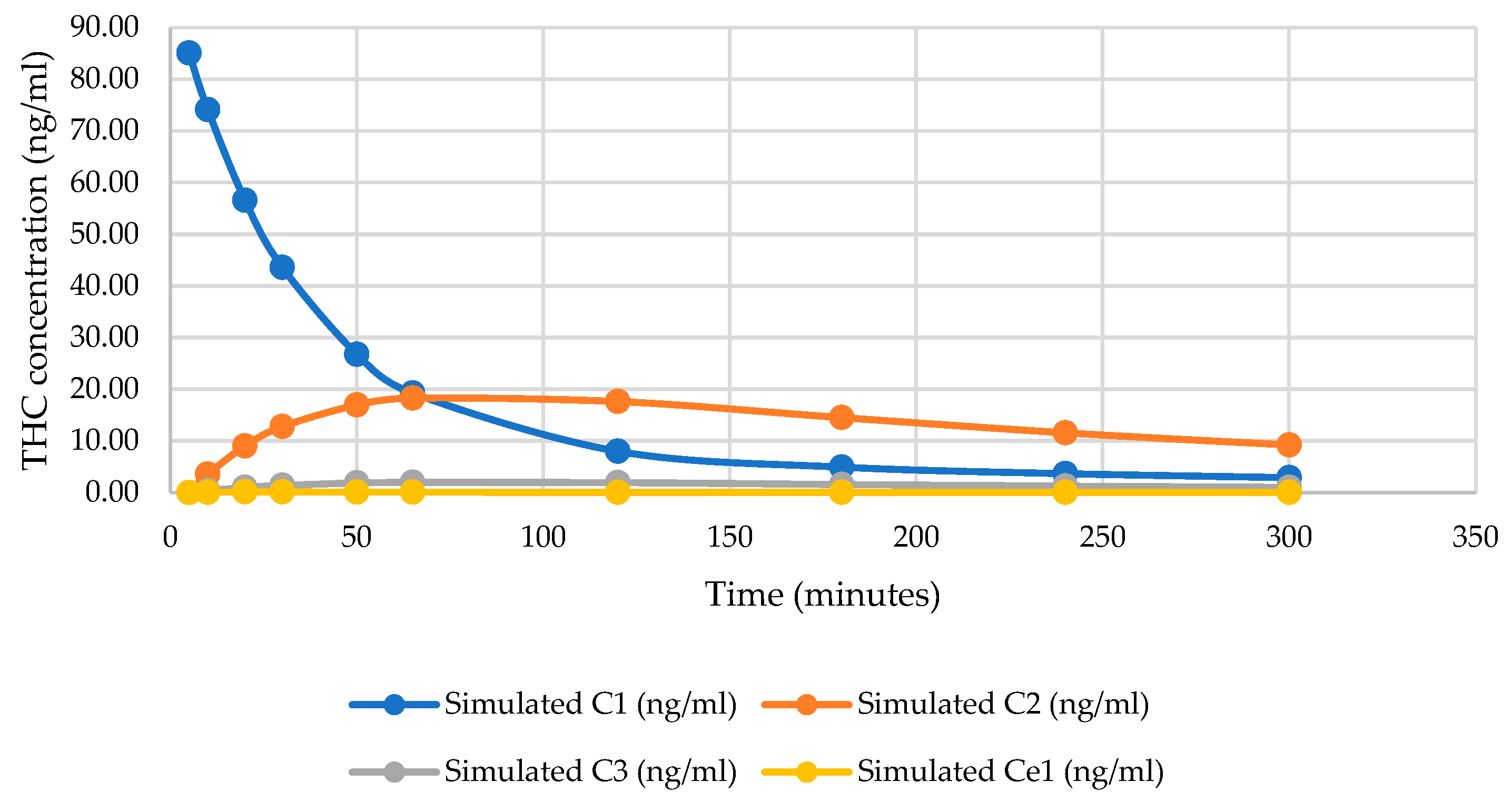A Compartment Pharmacokinetics Model of THC and Its Metabolites after Smoking †
Abstract
:1. Introduction
2. Methods
2.1. Compartmental Model
2.2. Data
3. Results
3.1. Exact Solutions
3.2. Simulation Results
3.2.1. THC Concentration
3.2.2. THC-OH and THCCOOH Concentration
4. Discussion and Conclusions
Author Contributions
Funding
Institutional Review Board Statement
Informed Consent Statement
Data Availability Statement
Acknowledgments
Conflicts of Interest
References
- Martin, W.A. Primer to Medicinal Cannabis: An Introductory Text to the Therapeutic Use of Cannabis; Bedrocan International: Veendam, The Netherlands, 2018; pp. 1–57. [Google Scholar]
- William, J.S.; William, E.W.; Joseph, T.D.; Robert, A.B.; Jane, M.P. Introduction to Pharmacokinetics and Pharmacodynamics. In Concepts in Clinical Pharmacokinetics, 6th ed.; American Society of Health-System Pharmacists: Bethesda, MD, USA, 2014; p. 2. [Google Scholar]
- Widmark, E.M.P. Principles and Applications of Medico Legal Alcohol Determination; Biomedical Publications in English; Biomedical Publications: Seal Beach, CA, USA, 1981. [Google Scholar]
- Khanday, M.A.; Rafiq, A.; Nazir, K. Mathematical models for drug diffusion through the compartments of blood and tissue medium. Alex. J. Med. 2017, 53, 245–249. [Google Scholar] [CrossRef]
- Rakesh, A. Application of Modeling-Based Approaches to Study the Pharmacokinetics and Pharmacodynamics of Delta-9-Tetrahydrocannabinol (THC) and Its Active Metabolite; The University of Iowa: Iowa City, IA, USA, 2017. [Google Scholar]
- Sempio, C.; Huestis, M.A.; Mikulich-Gilbertson, S.K.; Klawitter, J.; Christians, U.; Henthorn, T.K. Population pharmacokinetic modeling of plasma Delta9-tetrahydrocannabinol and an active and inactive metabolite following controlled smoked cannabis administration. Br. J. Clin. Pharmacol. 2020, 86, 611–619. [Google Scholar] [CrossRef] [PubMed]
- McBurney, L.J.; Bobbie, B.A.; Sepp, L.A. GC/MS and EMIT Analyses for Delta9-Tetrahydrocannabinol Metabolites in Plasma and Urine of Human Subjects. J. Anal. Toxicol. 1986, 10, 56–64. [Google Scholar] [CrossRef] [PubMed]





| Time after Smoking (min) | THC Concentration (ng/mL) | THC-OH Concentration (ng/mL) | THCCOOH Concentration (ng/mL) |
|---|---|---|---|
| 5 | 85.08 | 5.89 | 6.98 |
| 10 | 78.43 | 18.74 | 11.40 |
| 20 | 57.83 | 18.94 | 18.25 |
| 30 | 41.40 | 18.54 | 28.69 |
| 50 | 27.29 | 12.73 | 35.60 |
| 65 | 16.97 | 9.58 | 24.49 |
| 120 | 9.76 | 6.65 | 15.14 |
| 180 | 4.96 | 3.33 | 12.48 |
| 240 | 3.66 | 2.76 | 7.23 |
| 300 | 2.22 | 1.85 | 4.10 |
| Parameters | Values | Parameters | Values |
|---|---|---|---|
| 85.08 ng/mL | 0.0174 min−1 | ||
| 0.0091 min−1 | 0.0000 min−1 | ||
| 0.0067 min−1 | 0.0657 min−1 | ||
| 0.0010 min−1 | −0.0039 min−1 | ||
| 0.0003 min−1 | −0.0306 min−1 |
| Time after Smoking (min) | Actual THC Concentration (ng/mL) | Simulated THC Concentration (ng/mL) |
|---|---|---|
| 5 | 85.08 | 85.05 |
| 10 | 78.43 | 74.12 |
| 20 | 57.83 | 56.57 |
| 30 | 41.40 | 43.58 |
| 50 | 27.29 | 26.76 |
| 65 | 16.97 | 19.26 |
| 120 | 9.76 | 8.01 |
| 180 | 4.96 | 4.91 |
| 240 | 3.66 | 3.67 |
| 300 | 2.22 | 2.87 |
| Parameters | Values | Parameters | Values |
|---|---|---|---|
| 0.0144 min−1 | 0.0048 min−1 | ||
| 0.0013 min−1 | 0.0028 min−1 | ||
| 0.0112 min−1 | 0.0010 min−1 | ||
| 0.0009 min−1 | −0.0092 min−1 | ||
| 0.0004 min−1 | −0.0237 min−1 |
| Time after Smoking (min) |
Actual THC-OH (ng/mL) |
Simulated THC-OH (ng/mL) |
Actual THCCOOH (ng/mL) |
Simulated THCCOOH (ng/mL) |
|---|---|---|---|---|
| 5 | 5.89 | 7.02 | 6.98 | 11.95 |
| 10 | 18.74 | 11.60 | 11.40 | 19.76 |
| 20 | 18.94 | 16.00 | 18.25 | 27.24 |
| 30 | 18.54 | 16.77 | 28.69 | 28.56 |
| 50 | 12.73 | 14.32 | 35.60 | 24.38 |
| 65 | 9.58 | 11.83 | 24.49 | 20.13 |
| 120 | 6.65 | 6.15 | 15.14 | 10.48 |
| 180 | 3.33 | 4.09 | 12.48 | 6.96 |
| 240 | 2.76 | 3.15 | 7.23 | 5.36 |
| 300 | 1.85 | 2.50 | 4.10 | 4.26 |
Disclaimer/Publisher’s Note: The statements, opinions and data contained in all publications are solely those of the individual author(s) and contributor(s) and not of MDPI and/or the editor(s). MDPI and/or the editor(s) disclaim responsibility for any injury to people or property resulting from any ideas, methods, instructions or products referred to in the content. |
© 2023 by the authors. Licensee MDPI, Basel, Switzerland. This article is an open access article distributed under the terms and conditions of the Creative Commons Attribution (CC BY) license (https://creativecommons.org/licenses/by/4.0/).
Share and Cite
Mahahong, T.; Saleewong, T. A Compartment Pharmacokinetics Model of THC and Its Metabolites after Smoking. Eng. Proc. 2023, 55, 4. https://doi.org/10.3390/engproc2023055004
Mahahong T, Saleewong T. A Compartment Pharmacokinetics Model of THC and Its Metabolites after Smoking. Engineering Proceedings. 2023; 55(1):4. https://doi.org/10.3390/engproc2023055004
Chicago/Turabian StyleMahahong, Thanachok, and Teerapol Saleewong. 2023. "A Compartment Pharmacokinetics Model of THC and Its Metabolites after Smoking" Engineering Proceedings 55, no. 1: 4. https://doi.org/10.3390/engproc2023055004





